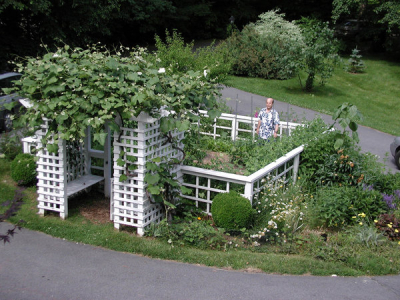
Lee Reich: Straight from the source
 I was going to end by telling
you that Weedless Gardening
is definitely a book worth checking out of your local library since it
is the simplest and clearest explanation of why and how to run a
no-till garden that I've read. But I got an email from the
author, who kindly overlooked my use of his copyrighted photos, and who
mentioned that he sells his books over on his website. It turns
out that a signed copy of Weedless
Gardening is only $8.95 direct from the author, with a very
minimal $2.50 shipping charge (at least to Virginia.) The book is
worth every penny of that price and more, so I've changed my tune ---
go buy a copy for yourself, and another copy for that nice neighbor who
can't seem to understand why you don't use a rototiller.
I was going to end by telling
you that Weedless Gardening
is definitely a book worth checking out of your local library since it
is the simplest and clearest explanation of why and how to run a
no-till garden that I've read. But I got an email from the
author, who kindly overlooked my use of his copyrighted photos, and who
mentioned that he sells his books over on his website. It turns
out that a signed copy of Weedless
Gardening is only $8.95 direct from the author, with a very
minimal $2.50 shipping charge (at least to Virginia.) The book is
worth every penny of that price and more, so I've changed my tune ---
go buy a copy for yourself, and another copy for that nice neighbor who
can't seem to understand why you don't use a rototiller.
Lee Reich also gave me a bit more information about his gardening
methods, which I wanted to repeat here for those of you who don't read
every comment on our blog:
As far as mulch, your garden is much bigger than most gardens, perhaps bigger than it has to be. I grow a year round supply of vegetables for me and my family on a couple of thousand square feet of space. Wood chips, perhaps a couple of loads per year are delivered free. Leaves are delivered free or I pick them up in suburban neighborhoods. I make many tons of compost from garden and kitchen waste, hay scythed from a half acre field here, and, occasionally, some horse manure waste from a local horse farm.
As far as the soybean meal, I've pretty much abandoned it. One inch depth of compost should supply all plants nutritional needs. Also, I question the killing of microorganisms from soybean meal; some will thrive on the N, others won't. The N is released slowly into the soil via the action of microorganisms. Chickens would mess up the garden and, anyway, don't provide free nitrogen if you feed them. (Mine get fed only enough to know where home is.) They mess up the beds so aren't allowed in my garden.
If you're still dying for more information, add Lee Reich's blog to your feed reader like I have. I'm sure he's got a lot more tips to share with us!
| This post is part of our Lee Reich's Weedless Gardening lunchtime
series.
Read all of the entries: |
Want more in-depth information? Browse through our books.
Or explore more posts by date or by subject.
About us: Anna Hess and Mark Hamilton spent over a decade living self-sufficiently in the mountains of Virginia before moving north to start over from scratch in the foothills of Ohio. They've experimented with permaculture, no-till gardening, trailersteading, home-based microbusinesses and much more, writing about their adventures in both blogs and books.
Want to be notified when new comments are posted on this page? Click on the RSS button after you add a comment to subscribe to the comment feed, or simply check the box beside "email replies to me" while writing your comment.

The trouble with mixing clover in with your vegetables is that it competes with them, and only gives nitrogen back when you mow it down. Some people suggest planting the clover in your aisles, then raking the clippings onto the beds for a boost of nitrogen at intervals.
Clover popped up in the aisles between some of my beds, which let me experiment with this technique, and I can't say I recommend it. The clover loves to send runners up into my vegetables, and I spend a lot of my weeding time ripping it out....
By the way, the RSS button is in orange at the top of the first comment.